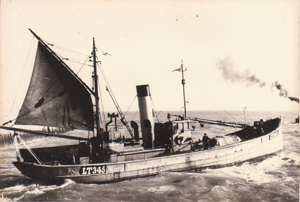Fishing Menu
- Introduction
- Why Yarmouth?
- Drift Net Fishing
- The Share System
- Life on Board
- Other Players
- Prunier Herring Trophy
- Front Page
- Lifeboat Shed Restoration
- Gorleston-on-Sea
Heritage Group - The Romans
- The 19th Century
- The Middle Ages
- The World Wars
- Shipwrecks
- Local Characters
- Local Interest Groups
- Local Transport
- Here & Now
- This & That
- GYBC & GYPA
Fishing Industry - A History
Fishing the North Sea for herring is thought to have been going on since Saxon times. The first documentary evidence about fishing is found in the Domesday Book and it refers to annual herring rents paid by local manors to their lord. During the Middle Ages Great Yarmouth tried to control the North Sea Herring fishing much to the chagrin of local neighbours Lowestoft.

The Two Masted Lugger
The rivalry between the two towns lasted until the demise of the Herring Industry. The wealth generated by fishing in the middle ages manifests itself in the many fine churches built on the coastal belt of Eastern England during this period.
Although the towns of Norfolk and Suffolk vied with each other in pursuit of the herring, by the mid-seventeenth century the Dutch fishing fleet had over two thousand boats. The number of boats fishing out of Great Yarmouth and Lowestoft at the time has been estimated as two hundred and fifty. However, by the early years of the ninteenth century, after years of conflict between England and Holland the Dutch fishing fleet had all but vanished.
The expansion of the East Anglian fleet was helped by the development of the three masted lugger. This type of vessel allowed larger catches to be made. Also Great Yarmouth had a harbour, a deficiency rectified by Lowestoft in 1830. Until then the boats at Lowestoft had to be beached, which meant the fishermen from this town had to use smaller boats. The arrival of the railways in the 1840s gave a boost to the fishing industry. There was now access to markets as far away as Manchester. This led to an increase in both the fishing fleet and populations of these fishing towns. Now the scene was set for the coming of the heyday of the herring fishing industry which lasted from about 1870 until the start of the First World War.
The catches during this period were prodigious. This was the time when it was said it was possible to walk from one side of Great Yarmouth harbour to the other, across the boats. By the end of this period Great Yarmouth had a fleet of over one thousand boats, three quarters of which made the autumnal trip from Scotland. Lowestoft had a massive fleet of over seven hundred and fifty boats, with over half coming from Scotland.
Between 1914-18 owing to the danger of attack by German Submarines, fishing all but ceased. Many drifters and trawlers were seconded by the Royal Naval as either patrol vessels or minesweepers. After the war it must have seemed like business as usual but it was soon obvious that all was not well. Catches declined steadily through the twenties and thirties. The fishing industry was not immune from the economics ravages of the Great Depression of the 1930's and during this period many businesses associated with fishing failed.

Lowestoft Drifter LT355
By the second world war the Great Yarmouth fleet had reduced to a quarter of what it had been in 1913. Fishing was halted for the period of the second world war. When fishing resumed it was obvious that even with the six years rest the herring were simply "no longer there". By the early sixties East Coast herring fishing industry was no more.
Lowestoft's drifting fleet struggled on until the late sixties. However, as Lowestoft has always had a trawling fleet the fishing industry here is not dead. Great Yarmouth and Lowestoft fishermen with a large measure of help from their Scottish counterparts and latterly from fishermen from the Common Market had hunted the herring to virtual extinction in the North Sea in the matter of a few years. As is always the case with such catastophic declines everyone could see it coming but nothing was done and then it was too late.
Sources and Bibliography Photograph of Drifter LT345 : Philip Overton


